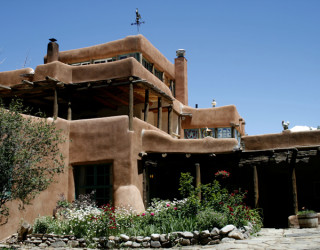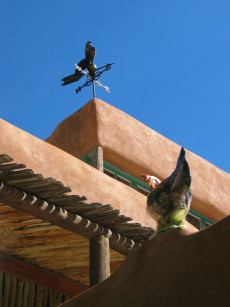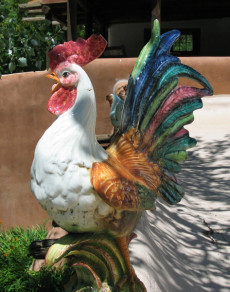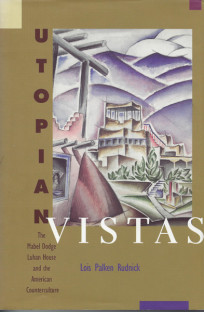by Elizabeth Cunningham
Every fall The Taos News features honorees exemplifying “Tradiciones” or the traditions of Taos. This year the “Raíces” (roots) section featured the Mabel Dodge Luhan House. Writer Teresa Dovalpage captured its essence in her opening sentence: “Declared a National Historic Landmark in 1991, the Mabel Dodge Luhan House is more than a historical place; it is a living, breathing haven for all creative types. Inspiration is everywhere…”
The article inspired a four-part serial on the House’s history. Beginning with Mabel, this overview profiles each of the successive owners and their accomplishments. Creativity is one theme that runs through this series. So does the Mabel Dodge Luhan House as a retreat center. Over the decades the property has provided respite from the outside world. This has allowed visitors and guests the time and space for reflection and change.
Mabel’s “Los Gallos”: 1918-1962
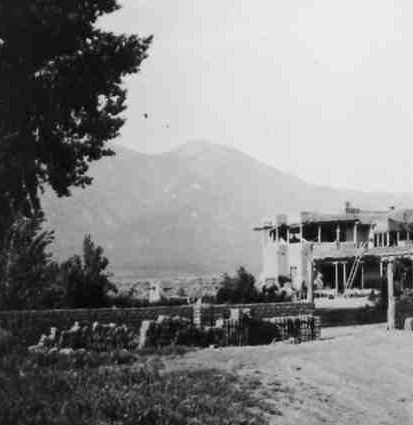
Mabel Dodge Luhan Collection. Courtesy of, Beinecke Rare Book and Manuscript Library, Yale University
In 1918 Mabel purchased twelve acres of land and a small adobe house from Manuel Trujillo. The acreage was bordered on two sides by Taos Pueblo land. Tribal member Tony Lujan, who Mabel later married, located the parcel for her. He organized and supervised a crew of Taos Pueblo and Hispanic men, and remodeled and added to the existing structure.
[NOTE: After marrying Tony, Mabel changed the spelling of her new surname from the Spanish Lujan to “Luhan.” She did this so that non-Spanish speakers outside of New Mexico would pronounce the name correctly, with the “h” sound. She hoped to avoid having it spoken as “Loo-john”.]
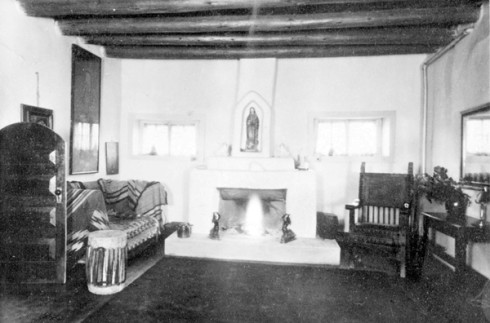
Mabel Dodge Luhan Collection. Courtesy of Beinecke Rare Book and Manuscript Library, Yale University
By 1922 the two-story Big House included a dining and living room, kitchen, and several bedrooms that lined the long portal (porch). Tony was responsible for designing and building the house; Mabel had charge of the interior. When the Big Room (living room) was completed, for example, she furnished it with an eclectic mixture of French, Italian, and Oriental sofas and chairs, European paintings, Indian blankets and pots, and two- and three-dimensional Hispanic santos (saints).
Originally Mabel named the complex Las Cruces, probably in reference to the two tall wooden crosses at the nearby morada (meeting house for the brotherhood of Hispanic penitentes. Georgia O’Keeffe and Paul Strand would later memorialize these crosses.) However, when her mail got sent to the town of Las Cruces, she renamed the estate Los Gallos (the roosters) after the brightly colored Mexican ceramic chickens placed along the roofline. The additions of more bedrooms, the Rainbow room, and a gatehouse became necessary to house guests and employees. The advent of visitors D. H. Lawrence and his wife Frieda in 1922 occasioned the construction of the first of several guesthouses.
Beginning in 1918 and through the late 1940s Mabel hosted numerous luminaries in Taos, many drawn from her salons in New York and Italy. These visitors included writers Mary Austin, Willa Cather, Aldous Huxley, Frank Waters, and Thorton Wilder; artists and photographers Ansel Adams, Dorothy Brett, Andrew Dasburg, Marsden Hartley, John Marin, Georgia O’Keeffe, Paul Strand and Edward Weston; American art collector and critic Leo Stein; composer Leopold Stokowski; choreographer Martha Graham; psychologist Carl Jung; social activists and anthropologists John Collier and Elsie Clews Parsons.
These visits to “Mabeltown” resulted in art, writing and performance pieces inspired by the diverse landscape, brilliant light, and native Hispanic and Pueblo cultures of northern New Mexico. Taken together with Mabel’s promotion of the area, they helped put Taos on the map. Their combined contributions, however, went well beyond Taos to make a lasting impact on twentieth-century American culture.
Mabel’s visitors and their creative contributions are the subject of a twenty-year study resulting in the forthcoming exhibition Mabel Dodge Luhan and Company: American Modernism and the West (opens May 2016 at the Harwood Museum of Art in Taos). The exhibition serves as visual and conceptual testimonial to the creative output of these visionaries. It also includes the work of native Hispanic and Pueblo artists who both served as inspiration for visiting modernists and created their own work inspired by them as well as examples from members of the Taos artist community from the early Taos Society of Artists through the modernists.
According to a 1946 letter, Mabel envisioned her home as a retreat for the “movers and shakers of the earth to relax and recover their energy.” Echoing attendees of her salons, these were people who Mabel had “always sought out.” She referenced them: “scientists, artists, statesmen, creators, promoters of values and changers of the world.” As Lois Rudnick points out in her book Utopian Vistas, the unique creative focus of each successive owner of Mabel’s estate embodied her concept. Each also contributed to the history, art and culture both of the house and of Taos.
Stay tuned for Part Two: Dennis Hopper and the “Mud Palace”: 1970-1978
For further information on Mabel’s era see Utopian Vistas by Lois Palken Rudnick. University of New Mexico Press, 1996.
See also The Taos News article, “Mabel Dodge Luhan House still a living, breathing artistic hub” by Teresa Dovalpage.
